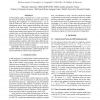Free Online Productivity Tools
i2Speak
i2Symbol
i2OCR
iTex2Img
iWeb2Print
iWeb2Shot
i2Type
iPdf2Split
iPdf2Merge
i2Bopomofo
i2Arabic
i2Style
i2Image
i2PDF
iLatex2Rtf
Sci2ools
ISBI
2007
IEEE
2007
IEEE
Validation and Comparison of Analytical Q-Ball Imaging Methods
Q-ball imaging (QBI), introduced by D. Tuch, reconstructs the diffusion orientation distribution function (ODF) of the underlying fiber population of a biological tissue. An analytical solution for QBI was recently proposed by several independent groups, using a spherical harmonic (SH) representation of the input signal. The methods differ primarily in the way SH are estimated. In this paper we validate these methods and compare them against Tuch’s numerical QBI on synthetic data, on a biological phantom and on a human brain dataset. We show that analytical QBI results in a speed-up factor of 15 over Tuch’s QBI, while providing results that are in strong agreement. We also show that at the cost of slightly reducing angular resolution, QBI with Laplace-Beltrami regularization provides the strongest robustness to noise and the most accurate detection of fiber crossings.
Diffusion Orientation Distribution | ISBI 2007 | Medical Imaging | Tuch’s Numerical Qbi | Tuch’s QBI |
| Added | 03 Jun 2010 |
| Updated | 03 Jun 2010 |
| Type | Conference |
| Year | 2007 |
| Where | ISBI |
| Authors | Maxime Descoteaux, Peter Savadjiev, Jennifer S. W. Campbell, G. Bruce Pike, Kaleem Siddiqi, Rachid Deriche |
Comments (0)

